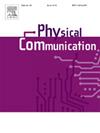Fairness driven TDMA with joint phase and beamforming optimization for ND-IRS assisted MU-MISO communication systems
IF 2
4区 计算机科学
Q3 ENGINEERING, ELECTRICAL & ELECTRONIC
引用次数: 0
Abstract
This paper investigates the optimization of rate performance in downlink intelligent reflecting surface (IRS)-assisted multi-user multiple-input single-output (MU-MISO) systems with a focus on fairness. The IRS operates in either diagonal (D) or non-diagonal (ND) configurations, with time allocation designed to maximize the minimum signal-to-noise ratio (SNR), effectively optimizing data rates for all users. The D-IRS configuration is commonly used due to its simplicity in implementation and control link load. However, ND-IRS allows signal reflection from different elements with adjustable phase shifts, enhancing system performance. The study examines how different IRS configurations and time allocation strategies influence data rates in a fairness-driven MU-MISO, time division multiple access (TDMA) transmission system. Using alternating optimization (AO) for the joint phase of the IRS and beamforming at the base station (BS), combined with fairness-based time allocation, the research explores the impact of transmit power, IRS elements, and user count on performance. Results show that ND-IRS with fairness-based time allocation consistently delivers the highest data rates across various scenarios. ND-IRS outperforms D-IRS, and random phase IRS setups, especially as transmit power and the number of IRS elements increase. Our results demonstrate that ND-IRS with fairness-based time allocation consistently achieves the highest data rates across various scenarios. For example, ND-IRS with fairness based time allocation performs better as compared to the equal time allocation scheme. Further, ND-IRS outperforms D-IRS with optimized phase as well as random phase IRS setups. Computer simulations confirm these findings.
求助全文
约1分钟内获得全文
求助全文
来源期刊

Physical Communication
ENGINEERING, ELECTRICAL & ELECTRONICTELECO-TELECOMMUNICATIONS
CiteScore
5.00
自引率
9.10%
发文量
212
审稿时长
55 days
期刊介绍:
PHYCOM: Physical Communication is an international and archival journal providing complete coverage of all topics of interest to those involved in all aspects of physical layer communications. Theoretical research contributions presenting new techniques, concepts or analyses, applied contributions reporting on experiences and experiments, and tutorials are published.
Topics of interest include but are not limited to:
Physical layer issues of Wireless Local Area Networks, WiMAX, Wireless Mesh Networks, Sensor and Ad Hoc Networks, PCS Systems; Radio access protocols and algorithms for the physical layer; Spread Spectrum Communications; Channel Modeling; Detection and Estimation; Modulation and Coding; Multiplexing and Carrier Techniques; Broadband Wireless Communications; Wireless Personal Communications; Multi-user Detection; Signal Separation and Interference rejection: Multimedia Communications over Wireless; DSP Applications to Wireless Systems; Experimental and Prototype Results; Multiple Access Techniques; Space-time Processing; Synchronization Techniques; Error Control Techniques; Cryptography; Software Radios; Tracking; Resource Allocation and Inference Management; Multi-rate and Multi-carrier Communications; Cross layer Design and Optimization; Propagation and Channel Characterization; OFDM Systems; MIMO Systems; Ultra-Wideband Communications; Cognitive Radio System Architectures; Platforms and Hardware Implementations for the Support of Cognitive, Radio Systems; Cognitive Radio Resource Management and Dynamic Spectrum Sharing.
 求助内容:
求助内容: 应助结果提醒方式:
应助结果提醒方式:


